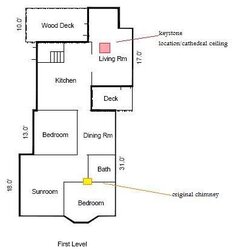The new stove (https://www.hearth.com/econtent/index.php/forums/viewthread/62293/#953071) was a game changer last winter; it is definitely nice to have that space excessively warm, instead of excessively cool.
The next stage is to try to move some heat towards the opposite end of the house. I haven’t done much analysis on this, but I was leaving the two thermostats (on first floor - natural gas furnace forced hot water) at around 57 during burns and each room further away from the stove would be approximately 10 degrees cooler - if we got the woodstove room up to 85, the kitchen was 75, the dining area would be 65, the rest of the house would stay at what the thermostat was set for… a balmy 57. (fyi -I’m not concerned with the second floor)
Cathedral ceilings aren’t ideal for woodstoves, and I estimate that the temperature near the peak of the ceiling is around 100 degrees during burns. This is trapped heat and (I think) essentially wasted.
The plan is to add a vent near the top of the ceiling, run some type of duct through the wall into the basement. Continue with insulated duct work (through the unconditioned basement) to the front of the house. Put an inline fan to push/pull the hot air through the duct.
This brings up a number of questions… mostly in regards to sizing (fan and duct diameter), also what kind of losses I’ll see (temp at outlet). I want to start cheaply… maybe not even run a duct through the wall at first… I think that would likely be the hardest part but do have a plumbing gangway that may be easier to access/modify than a normal wall cavity.
I’ve seen posts on this topic… but not been able to find anyone with a working setup like this. Here’s one link with some calculations which look promising:
http://cr4.globalspec.com/thread/62365/heat-ducting-for-wood-stove
Any thoughts/experiences out there on pulling hot air through a duct and basement to another part of a house? Has anyone tried this???
Thanks!
The next stage is to try to move some heat towards the opposite end of the house. I haven’t done much analysis on this, but I was leaving the two thermostats (on first floor - natural gas furnace forced hot water) at around 57 during burns and each room further away from the stove would be approximately 10 degrees cooler - if we got the woodstove room up to 85, the kitchen was 75, the dining area would be 65, the rest of the house would stay at what the thermostat was set for… a balmy 57. (fyi -I’m not concerned with the second floor)
Cathedral ceilings aren’t ideal for woodstoves, and I estimate that the temperature near the peak of the ceiling is around 100 degrees during burns. This is trapped heat and (I think) essentially wasted.
The plan is to add a vent near the top of the ceiling, run some type of duct through the wall into the basement. Continue with insulated duct work (through the unconditioned basement) to the front of the house. Put an inline fan to push/pull the hot air through the duct.
This brings up a number of questions… mostly in regards to sizing (fan and duct diameter), also what kind of losses I’ll see (temp at outlet). I want to start cheaply… maybe not even run a duct through the wall at first… I think that would likely be the hardest part but do have a plumbing gangway that may be easier to access/modify than a normal wall cavity.
I’ve seen posts on this topic… but not been able to find anyone with a working setup like this. Here’s one link with some calculations which look promising:
http://cr4.globalspec.com/thread/62365/heat-ducting-for-wood-stove
Any thoughts/experiences out there on pulling hot air through a duct and basement to another part of a house? Has anyone tried this???
Thanks!



